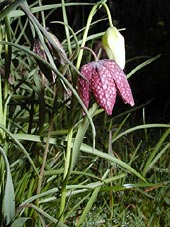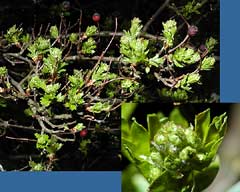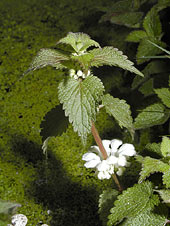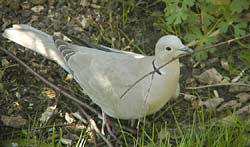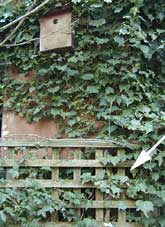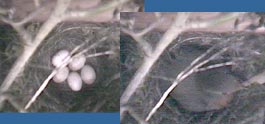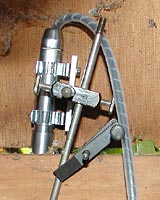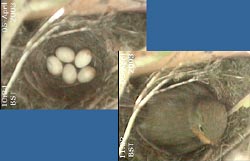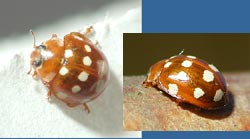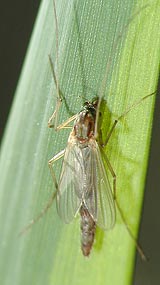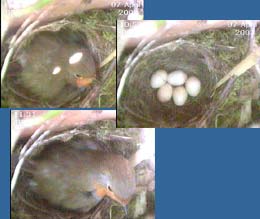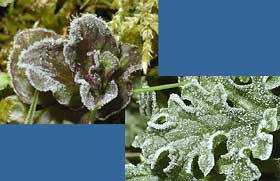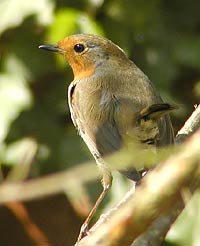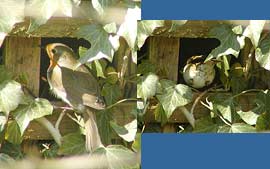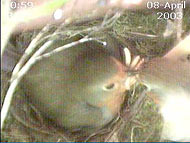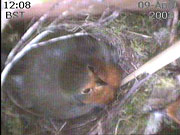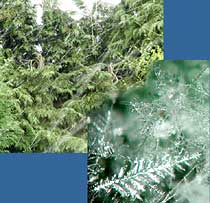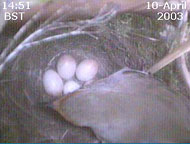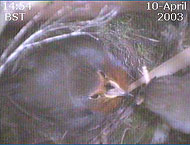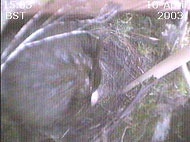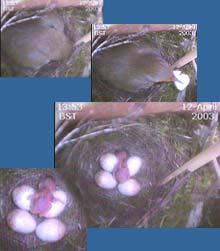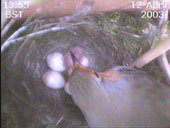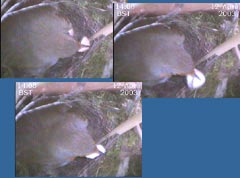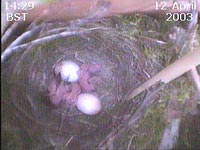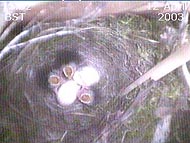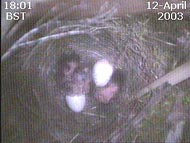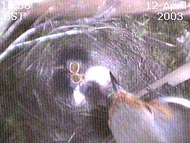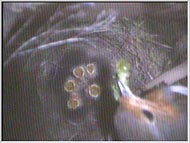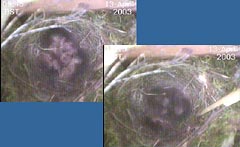Go to last entry........... ............................Go to previous entry
The first Snake's-head Fritillary flower opened yesterday evening. It looks as though we shall have quite a few flowers for the short time they are in bloom. I shall have to start watching out for the Scarlet Lily Beetles that have appeared on the plants in the last two years.
The Hawthorn is now turning quite green as the new leaves open up and the bunches of flower buds develop. As you will see from the photograph, the tree still bears some of last year's berries.
In a couple of places in the garden the White Dead-nettle plants have come into flower. This one is growing out over the side of the small pond.
Here, a dove is collecting one of a number of birch twigs that I put down for it.
I knew that the robins are nesting somewhere at the bottom of the garden, but not in the boxes they have used previously. What I didn't realise until late this afternoon was that their chosen spot was not in the Leylandii, but hidden behind the trellis below the Blue Tit box! I spotted one of them entering through the opening arrowed in the photograph.
Conveniently, when I built the birdbox I left a gap between the upper and lower side panels, so I was able to take a sneaky look using a small mirror. The nest was clearly in view and contains five eggs.
Just after I connected the camera to a tv in the house the male robin went in and fed his partner with a mealworm. It was too late in the day to fiddle with it much as the female robin obviously wanted to get back to incubating the eggs. Tomorrow I shall see if I can add a tiny bit if light which will come on in the daytime only.
I saw the first butterfly of the year cross the garden today. I think it was probably a Holly Blue.
The male has fed his partner numerous times during the day, but I haven't managed to capture the brief encounter as yet
Just as when I followed the robins nesting back in 2000, the female is very sensitive to disturbance so I have to be very cautious whenever I approach the birdbox, especially if I need to climb up inside. So that I did not disturb her too much today I have not yet set up a light, although it is ready and will be fitted tomorrow. It will only be switched on during the day, and as some sunshine reaches the nest during the morning I am not concerned that the light will have an adverse effect. I will be switching the webcam to the Robin every-so-often, although the Blue Tits will have priority as I cannot manage to get both on line at the same time - perhaps next year! As the temperature climbed to nearly 20C in the confines of the garden (it was warm enough for shorts today!) two more butterflies were spotted this afternoon. The first was a Large White, and the second a yellow butterfly, possibly a Brimstone.
I think it is a Calvia 14-guttata - a 14 spot ladybird.
There were lots of flying insects about in the sunshine today, from Bumble and solitary bees, wasps, down to non-biting midges like this one, which is similar to Chironomus plumosus. The lack of feathery antennae indicates that this is a female.
While we sat outside this afternoon, a Sparrowhawk attacked the Hawthorn and caught a Starling which struggled and cried out loudly. We were surprised when after a short struggle, the hawk suddenly released it and flew off, leaving the Starling behind. Although obviously injured, the Starling took only a minute to recover enough to fly off with little problem.
I recorded a four hour period of Robin video when the garden was not used, from 10am this morning, and I have just looked through it to get the following figures: During that time she turned the eggs 17 times - just over 4turns/hour. She left the nest for a total of 30 minutes. Several times when she had left the nest she would return, only to leave again immediately. Counting those 'double departures' as one trip, she left the nest 7 times in total. She was fed by her partner 12 times. On one occasion he brought in three food offerings in quick succession, but took the last one away again when the female did not respond immediately. I have put a very dim light above the nest (no good for webcam use) and I was surprised to see that she continued to take trips from the nest right up to 9pm, long after it was dark outside. I have bought a white light LED torch which I have added a diffuser to and will experiment with tomorrow to give more consistent lighting during the daytime. If it works it will be controlled by the same timer used in the Blue Tit box (I've just noticed that that has not switched off this evening so I need to check it in the morning. I may have inadvertently pressed a switch on it and cancelled the 'auto' mode).
For much of the day I was distracted by other business, but I did spend a short time watching the area of the birdbox. This picture of one of the Robins in the Birch shows what is a typical wary, watchful pose. It was very cautious, and several times approached near to the nest only to move away again if something disturbed it. If it went too high in the Birch it got into trouble with the Blue Tits. One was very agressive, presenting its claws towards the Robin which withdrew to the lower branches.
Eventually, the Robin approached the entrance to the nest space, and after another catious lokk around it finally entered. The nest had been empty and this Robin settled on the eggs, so I assume it is the female.
Feeding of the female continues, and this is a webcam image of one such moment seen during the morning. They are mealworms that I scatter on the ground at the bottom of the garden for both the Robins and the Blackbirds.
Lighting of the Robin nest continues to be a problem. I do not want the risk disturbing her so I only make adjustments infrequently. I have set up a white light LED torch but although it shows up the eggs well, the bird's brown plumage still remains very dark. The lighting does allow me to watch the nest more easily throughout the day, but it is just not good enough for the webcam once the sun has moved round into the South-West. 9 April - A cold, cloudy day today with a bit of rain and some soft hail (or was is snow?). The birdbath needed hot water treatment again this morning.
The snow kept falling for a couple of hours but melted as soon as it landed and I tried in vain to get a good image of the snowflakes which turned to water quicker than I could focus on them. The smaller image illustrates the nearest I got to success!
Every time I approach the bottom of the garden the female leaves the nest. Soon after I come back to near the house she returns, as in this image.
The mealworms I have scattered near the Ivy tree are soon found and I need to get back in the house quite quickly to catch images like this one as the male delivers another one to his partner.
Here she is busy turning the eggs, a job that I understand ensures that the eggs are warmed evenly, and prevents the embryonic membranes from sticking to the shell.
12 April -BREAKING NEWS - The Robins' eggs have hatched today.
This morning was no different than usual, and at 1.53pm, when the female's head went down I assumed that it was another bout of egg turning. Then she brought up a large piece of shell. She left the nest to reveal the first of her chicks, sprawled over the other eggs.
She returned a couple of minutes later and settled on the nest.
About fifteen minutes later she started bring up more shell pieces from the nest, although this time she ate them.
When she next left the nest we could see three very pink chicks wriggling about between the two remaining eggs.
Here they are a short time later, already hungry and imatiently waiting somebody to feed them.
It was early evening before the next egg hatch just after 6pm. Here the chick is still emerging from the larger part of the shell, its parent having eaten the other bit.
We had nearly reached 'lights out' time at 7.30pm when the final egg cracked. As I watched the TV screen the chick forced the two halves apart before mum returned. Once she sat on the nest her head went down and I assume she removed the shell before settling down for the night.
During the day the male has continued to bring food to the nest. He passes it to his partner who then ducks down to pass it on to one of the chicks. She also brought food with her when she returned from her trips. While she is sitting on the chicks it's as though she has hiccups - her body bounces up and down as the chicks move about below her!
In this image from earlier in the day, you can just see the mass of very dark down that gives each chick an amusing looking 'hair style'. It would be nice to get close-ups of them at this stage but I'm afraid this is the closest that I can get to this family.
13 April - After yesterday's long entry, a shorter one today. During the day, feeding has gone on at a less than frantic pace, although I'm sure that this will change in the days to come. Most of the time it is the male who brings food, and as pictured yesterday, passes it to his partner who themn gives it to a chick.
Yesterday I mentioned the down on the heads of the chicks. Well, it seems to be on their backs as well, and these tow images show how they can almost 'disappear' when they are face down in the nest. Could this down have a double purpose at this stage, that of insulation and a touch of camouflage?
I am travelling to Cornwall for about the next ten days so, while the webcam will continue, there will be no further diary entries until I return. Unfortunately, this will take us very close to the chicks' fledging (12-15 days after hatching), but I hope to be home to see that happen. I aim to check on the webcam while I am away and if there is a problem one of my sons will, hopefully, sort it out quite quickly. In my absence the webcam will continue to cover the Robins' nest with images refreshed every 15 seconds. My computer will save an image every minute so that I have a record to look through on my return. This means that I will miss a great deal of the action, so I will be very grateful for any interesting images that you may be able to capture and e-mail to me. I should point out that the light used for the nest is only on between 6.30am and 7.30pm BST (approx), so there will be night-time images until I return. |
|
